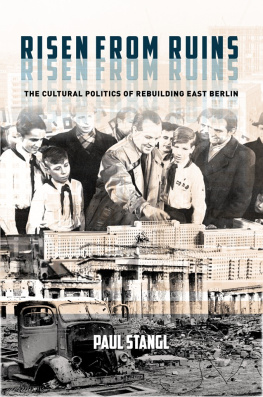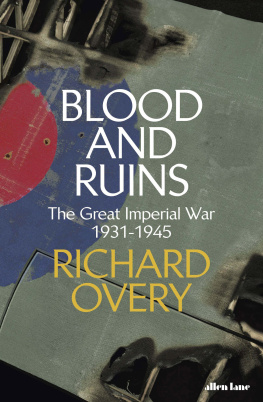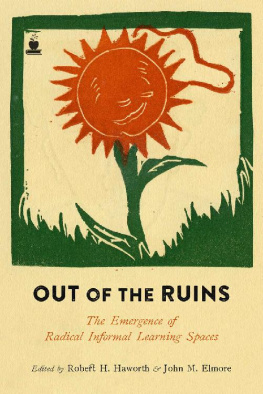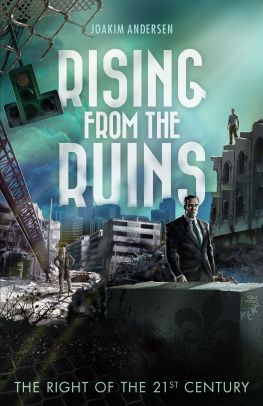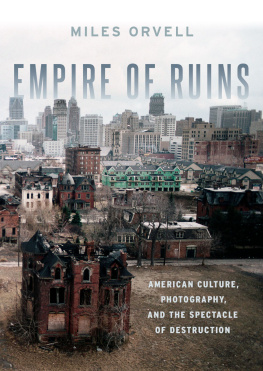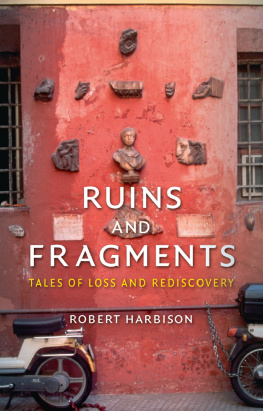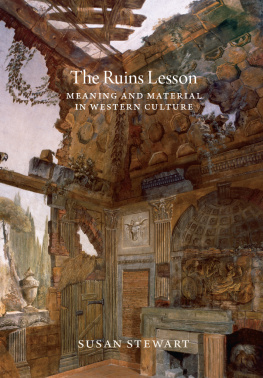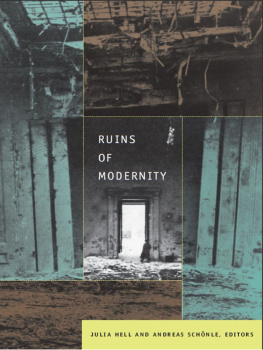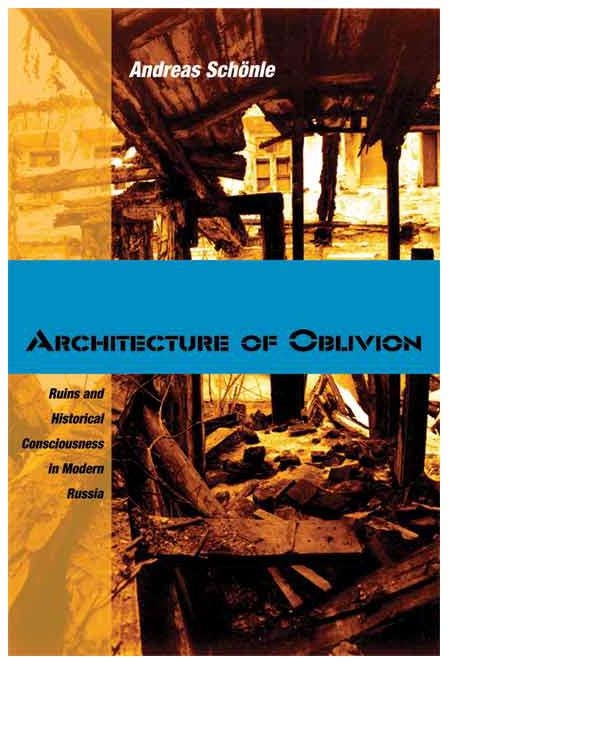
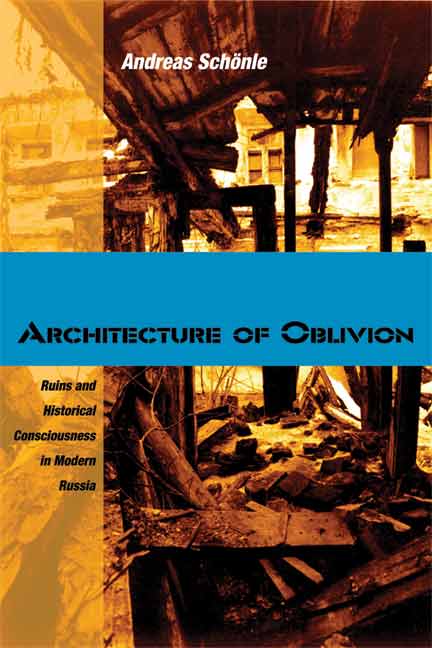
Architecture of Oblivion
Ruins and Historical Consciousness in Modern Russia
Andreas Schnle
NORTHERN ILLINOIS UNIVERSITY PRESS DeKalb
2011 by Northern Illinois University Press
Published by the Northern Illinois University Press, DeKalb, Illinois 60115
Manufactured in the United States.
All Rights Reserved
Jackt design by Julia Fauci
First digital edition, 2011
eISBN 978-1-60909-020-3
Library of Congress Cataloging-in-Publication Data
Schnle, Andreas.
Architecture of oblivion: ruins and historical consciousness in modern Russia / Andreas Schnle.
p. cm.
Includes bibliographical references and index.
1. Architecture and societyRussiaHistory. 2. Architecture and societySoviet UnionHistory. 3. ArchitectureRussiaAestheticsHistory. 4. ArchitectureSoviet UnionAestheticsHistory. 5. City and town lifeRussiaHistory. 6. City and town lifeSoviet UnionHistory. 7. RussiaHistoryPhilosophy. 8. Soviet UnionHistoryPhilosophy. 9. RussiaAntiquities. 10. Soviet UnionAntiquities. I. Title.
NA2543.S6S36 2011
720.947dc22
2011001146
Tis safer to be that which we destroyThan by destruction dwell in doubtful joy.Macbeth , act 3, scene 2
Contents
4 Ruins and the Modern City in the Depth of Times
5 From the Return of Random Beauty to the Dystopian Loss of Self
8 Paper Architects and the Vitality of Decay
Acknowledgments
This book would not have existed without Julia Hell, who casually suggested to me, during a boring Christmas party in 2000, that we collaborate on a project about ruins. This brief, innocuous conversation led to a symposium, then a graduate seminar we co-taught at the University of Michigan, then a major interdisciplinary conference, and eventually to a collective interdisciplinary volume entitled Ruins of Modernity , which came out at Duke University Press in 2010. All along, we had intended that we would separately write a monograph, each on our respective sphere of expertise. And so Julia is completing her manuscript on Imperial Ruins: Imagining the Decline of Rome from Napoleon to Hitler , while I sought in this book to make sense of Russias convoluted relationship to its ownand its neighborsruins. Perhaps the readers will agree that these books are convincing proof that even tedious holiday parties are worth attending. The passing of time could not possibly erode the gratitude I harbour toward Julia.
Many colleagues generously shared their expertise and resources with me, and they did so in more ways than I could possibly acknowledge here. The graduate students in our ruins seminar and the contributors to our conference helped sharpen my understanding of the inexhaustible potential of ruins. Conversations with trusted friends such as Jeremy Hicks, Boris Katz, Catriona Kelly, Tatiana Smoliarova, and Andrei Zorin inspired seminal new thoughts. Specialists I consulted in Russia warmly encouraged my ideas. The late and sorely missed David Sarkisyan opened up his address book and made various calls on my behalf. His collaborators at the Shchusev State Museum of Architecture in MoscowI.V. Sedova, the chief curator, as well as L.G. Rassadnikov and M.G. Rogozinarevealed to me some of the tantalizing ruins hidden in their collections. N.G. Shabalina, Iu.M. Solonovich, and I.A. Zolotinkina, all from the Russian Museum in St. Petersburg, did likewise. V.E. Loviagina at the State Museum of the History of St. Petersburg kindly shared her knowledge of representations of the Leningrad Blockade. Some of the most prominent scholars of architectural history in Russia such as A.L. Batalov (Museum of the Moscow Kremlin), Grigorii Kaganov (European University) and Vladimir Sedov (Proekt Klassika), spent long hours in lively conversations about the destiny of ruins. Petr Belyi, Alexander Brodsky, Mikhail Filippov, and Ilya Utkin, the contemporary artists I discuss toward the end of this book, were eager to reflect on their work, but also more broadly on the place of ruins in the fabric of postmodern cities.
My work on this volume has been facilitated by The Leverhulme Trust, which provided for replacement teaching while I spent a year researching my book. In addition, the British Academy awarded me a Small Research Grant for travel expenses to conduct research in Russia. Finally, the School of Languages, Linguistics, and Film at Queen Mary, University of London not only supported my research leave, but also funded several conference presentations, where I had the opportunity to receive helpful feedback on my work. I am immensely grateful for the confidence these organizations placed in me.
A few sections of this book appeared in print in an earlier version. My thoughts on the theory of ruins and on Karamzins Poor Liza were published in Novoe literaturnoe obozrenie , in vol. 95 (2009) and vol. 59 (2003) respectively. A shorter version of the section on Tolstoys response to the Moscow fire of 1812 was included in the interdisciplinary volume Ruins of Modernity , which I edited together with Julia Hell at Duke University Press (2010). Finally, my remarks on Pushkins response to Karl Briullovs famous painting The Last Day of Pompeii were published in a Festschrift dedicated to A.L. Ospovat entitled I vremia i mesto (Novoe izdatelstvo, 2008). I thank the editors of these journals and books for permission to use these essays here in a revised version.
It was a genuine pleasure to work with Amy Farranto, the Acquiring Editor for the Russian Studies Series at Northern Illinois University Press, who made a number of suggestions, which vastly improved this volume. Her response time to e-mails was nothing short of astonishing. I am also grateful for the support of my peer reviewers, Douglas Smith and an anonymous colleague, who spoke more eloquently of my work than I could have done myself. At an earlier stage of the manuscript, Anne Tempest patiently and meticulously turned my prose into proper English. And as copy editor, Judith Robey efficiently enforced a rigorous discrimination between US and British English.
Last but not least I thank my wife Snejana Tempest and my two children, Marianne and Oliver, who ensured through their unconditional kindness and loveand especially their unabated livelinessthat I would not turn into one of the objects I was studying!
A Note on Transliteration
The Library of Congress transliteration system has been used throughout, except in the case of names for which an established English spelling exists.
Introduction
The world is truly puzzling to me!Why is the view of steep, rocky mountainsand ruins so pleasant to all? This is nonsense:To me a threshing barn and a shedAre better than any ruin,For at least they have some use:Ah des ruines, moi je men moque.A house without a roof and windows,For cats only is good,Or for rats, but not for people.I. Miatlev, The Sensations and Observationsof Madame Kurdiukova Abroad, dans
ltranger1The provincial Madame Kurdiukova, who speaks in this epigraph, is the heroine of Ivan Miatlevs humorous parody of travel literature, The Sensations and Observations of Madame Kurdiukova Abroad, dans l tranger (1840). A landowner from Tambov who likes to flaunt her learning by sprinkling macaronic phrases in her speech, she is representative of a particular attitude, pretentious and irreverent, that is characteristic of the way that semi-educated people of her class are depicted in Russian literature. It is the view of the famous castles on the Rhine, a central topos in German Romantic culture, that prompts her categorical dismissal of ruins and her reassertions of pragmatic values. Regardless of her cultural pedigree, in her insensitivity to ruins she hardly stands alone in Russian culture. In A.N. Maikovs Promenade in Rome with My Acquaintances (1848), Andrei Blagochinnyi, a well-connected parvenu who quickly achieved high rank and amassed considerable sums of money in St. Petersburg, but who confuses religious and architectural orders, is much surprised as he walks through ancient Rome:
Next page



